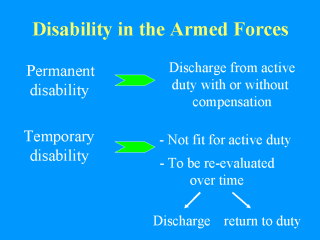| front |1 |2 |3 |4 |5 |6 |7 |8 |9 |10 |11 |12 |13 |14 |15 |16 |17 |18 |19 |review |
 |
The spectrum of
disability of interest to the armed forces is, not surprisingly, different from that for
the general population. This perspective revolves around economic concerns and fitness for
active duty. The personnel departments of each of the military services are responsible for the review and disposition of cases where an individual either (1) incurs an injury or disease while on active duty or (2) whose prior health condition may be aggravated by military service and, therefore, may be eligible for some form of compensation. For active duty military personnel, disability can be most immediately viewed from two perspectives – whether its impact is permanent or temporary. Permanent disability results in discharge of the individual from the service. Temporary disability results in the loss of active duty status over a period of days, weeks, or years. Physical disability that results in discharge from the service carries significant compensation costs. In 1993, the lifetime cost of new disabilities compensated by the Army was about $500 million annually. This lecture reviews the existing data sources for disability in the Armed Forces to identify the relative contribution of injuries, and to identify recommendations regarding the surveillance of injury-related disability in the military. |